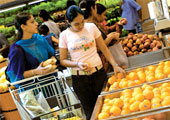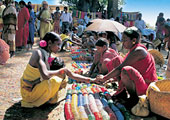|
Medieval
Europeans called India a "golden bird" and managed to
cage it for centuries. But now, it's ready to spread its wings
and fly again. And this time too, the world is sitting up and
taking note. "That incomes will leap is a fait accompli,"
says Hemant Sachdeva, Director (Marketing), Bharti Airtel, "and
all indications are that the increase will be secular."
Sachdeva's optimism is not unfounded. Consider
this: an average Indian today can potentially spend double of
what he could in 1985; in the next 20 years, he will be able to
spend four times what he does now, says a McKinsey Global Institute
report titled The Bird of Gold: The Rise of India's Consumer Market.
Result: India is expected to emerge as the world's fifth-largest
consumer market by 2025, overtaking countries like Germany and
Italy which are currently far ahead.
Providing ballast to this ride up the ranks
of consuming nations is the country's expected annual growth rate
of 6-9 per cent per annum (real compounded annual growth of 7-8
per cent) over the next two decades. This will almost treble middle
class income levels-average real disposable incomes will grow
from Rs 1,13,744 in 2005 to Rs 3,18,986 in 2025-and ensure that
just over a fifth (22 per cent) of India's population remains
desperately poor, compared to more than half (54 per cent) today.
Simply put, 291 million Indians will move out from an existence
of desperation into a more sustainable life.
 |
| By 2025, India's middle class is expected
to swell almost 12-fold from its current size of 50 million
to over 583 million people |
Middle Class to Fuel Boom
These developments will have a major impact
on what Indians buy and consume, how they go about it and also
what marketers offer them. By 2025, India's middle class is expected
to swell almost 12-fold from its current size of 50 million (other
studies have placed it at 200-300 million) people to over 583
million and make up to 41 per cent of the population. "The
sheer buying power of this emerging middle class will drive the
economic engine," says Adil Zainulbhai, MD, McKinsey India.
"In the future, there will be greater stress on the aesthetic
value of products," feels Girish V. Rao, VP (Marketing),
LG India, adding: "Durables like high-end refrigerators are
already growing at 20-25 per cent per annum."
The report predicts that aggregate consumption
will double from Rs 17 lakh crore today to Rs 34 lakh crore by
2015 and quadruple to Rs 70 lakh crore by 2025. A caveat: per
capita spending in 2025 will remain modest at Rs 48,632.
Numbers aside, the report predicts that by
2025, the class structure of consumers will change. The new middle
class (with real earnings of Rs 2-10 lakh p.a.) and the global
class (earnings of more than Rs 10 lakh p.a.) will account for
79 per cent of total spending. Currently, consumers in the "deprived"
and "aspirer" income segments (defined as those with
annual household incomes of less than Rs 90,000 and Rs 90,000-2,00,000,
respectively) account for about three quarters of total spending.
"About 12 per cent of our customers fall within the aspirer
segment now," says Kishore Biyani, md, Future Group, which
owns the Pantaloon and Big Bazaar retail chains.
Discretionary Spends
By 2025, three-fourths of consumer spending
will be discretionary, compared to just over half today. While
Indians will continue to spend nearly a fourth of their disposable
income on basic necessities, more than half the spend will be
on transport, healthcare, personal products and education. The
Marutis, Fortises and Hindustan Unilevers of this world, please
take note. "In the next 10 years, we expect the four wheeler
auto industry to grow at a CAGR of 10 per cent," informs
Rajesh Jejurikar, Senior VP (Marketing), Mahindra & Mahindra.
And there's good news for the country's booming telecom sector
as well. The spend on communications will grow at 13 per cent
per annum through 2025 and account for six out of every hundred
rupees spent. "The key will be penetration," says Bharti's
Sachdeva. "If you are not available before actual demand
kicks in, you've lost the game," he adds.
 |
 |
| The distribution of wealth,
though still lopsided, will be a lot more equitable by 2025
than at present |
Urban-Rural Gap Will Close
In 2025, the report predicts, urban India
(with real annual household incomes growing at 5.8 per cent) will
remain the main driver of consumption and wealth creation, accounting
for 62 per cent of the total spends, but rural incomes, too, will
register an upswing. The growth rate in annual rural income per
household will accelerate from 2.8 per cent over the last two
decades to 3.6 per cent over the next two; and rural consumption
will reach the level of today's average urban household by 2018.
"As rural India enters the post-modern economy, agriculture
will become a smaller part of the whole pie, thereby significantly
increasing the buying power of rural markets," says McKinsey's
Zainulbhai. Adds LG's Rao: "Today, rural penetration in the
consumer electronics market is just about a tenth of the urban
reach; this will change, especially when consumer finance reaches
the villages."
Even within urban areas, India's mid-tier
and smaller cities, which will be home to almost two-thirds of
India's middle class population, will emerge as increasingly attractive
markets. In fact, mid-sized cities like Chandigarh, Ludhiana and
Amritsar already have higher average incomes than their top-tier
counterparts. And if marketers like Rao are to be believed, B
and C class cities, and even semi-urban areas like Vellore and
Hissar, are already taking to the replacement market. "The
second-hand market for most home durables in these cities is dying,"
he says.
 |
| Mid-sized cities like Chandigarh, Ludhiana
and Amritsar already have higher incomes than their top-tier
counterparts |
The Challenges
The growing consumer market will also throw
up several challenges before the state and the private sector.
For one, such stupendous growth hinges on the state continuing
to pursue a pro-reform, pro-growth agenda. "The biggest challenges
that the government needs to address are in education and infrastructure,"
says Zainulbhai, adding, "private enterprise will take care
of the rest." However, analysts fear that if fundamental
reforms promised by the government do not come through, the market
will lose its sheen. Marketers will also have to offer high-end
products at affordable price points. "Moreover, individual
companies will have to keep in mind that the customer of the future
will be extremely conscious of the cost of energy," says
LG's Rao. "We will necessarily have to bring in smarter technologies."
The adventurers of yore had to cross the
seven seas and overcome numerous obstacles in their quest for
the golden bird. The marketers of tomorrow will face similar challenges-the
form will have changed, but the content will remain the same.
|









